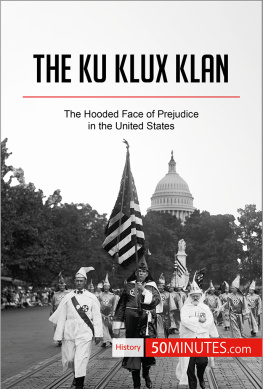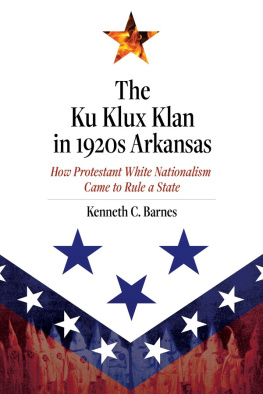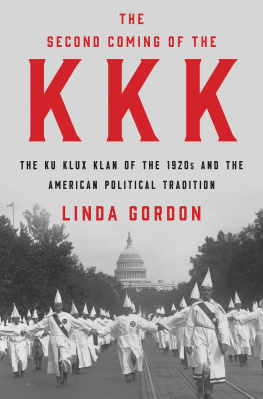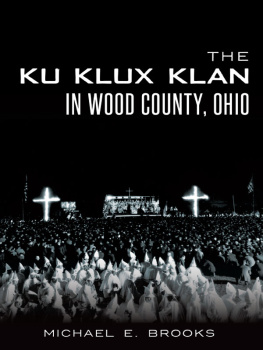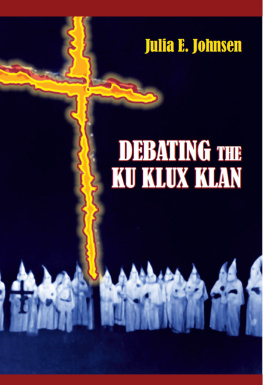The Ku Klux Klan in
the Southwest
THE
KU KLUX KLAN
in the Southwest
Charles C. Alexander

COPYRIGHT 1965 BY UNIVERSITY OF KENTUCKY PRESS
LIBRARY OF CONGRESS CATALOG CARD NUMBER: 65-11831
Contents
Preface
A T THE MENTION of the words Ku Klux Klan, most people, including many historians, immediately conceive of a band of sadistic Southerners in white robes and hoods intimidating hapless Negroes. In the popular mind the Klan is a fanatical, violent, white supremacy society, dedicated to keeping the nigger in his place. The average citizen does not realize that historically there are not one but three Klans. The first was the Ku Klux Klan of the Reconstruction periodsecret, political, often violent, preoccupied with turning out the Radical Republican state and local governments in the South and with proscribing the recently emancipated Negroes and their white Republican allies. Then there was the Invisible Empire, Knights of the Ku Klux Klan, Inc.also secret, frequently violent, and white supremist, but unlike the Reconstruction Klan, ultra-patriotic, nativistic, and moralistic. The formal history of this organization extends from 1915 to 1944. The third Klan is in reality several organizationsthe various anti-Negro societies, using the name of the previous Klans, which have appeared from time to time in the southern states since the end of the Second World War.
The modern-day image of the Ku Klux Klan stems largely from the first and third Klans, organizations confined to the southern states and concerned primarily with throttling ambitious Negroes and whatever white sympathizers they might have. It is the middle Klan, however, the secret fraternal order which had its heyday in the 1920s, that is the subject of this study. The Invisible Empire, Knights of the Ku Klux Klan, Inc., was nationwide, spreading into every state in the Union and recruiting perhaps five million Americans to its many-sided cause. The Klan of the twenties was an enemy not only of Negroes but of Catholics, Jews, radicals, immigrants, bootleggers, moral offenders, habitual criminals, modernist theologians, and assorted other types. Its high-flown rituals, exotic nomenclature, and charity work made it, in a narrow sense, like the numerous other adult fraternal orders in America. Yet the Klan differed from the respectable lodges in that not only its ritual but its membership was secret. In most areas where it became strong, the Klan evolved into a political machine which often backed entire slates of candidates and tried to vote its members as a bloc. Finally, it was a giant financial organization which received and disbursed millions of dollars and became one of the most profitable businesses of the prosperity decade.
This study focuses on the career of the Knights of the Ku Klux Klan in Texas, Louisiana, Oklahoma, and Arkansas. I have, rather arbitrarily, termed the area encompassed by these four states the Southwest, knowing full well that such terminology will probably offend many, and that culturally, Louisiana, Arkansas, and Texas were predominantly southern in the twenties, while Oklahoma bore strong southern influences. I have referred to the four states as the Southwest for purposes of simplicity and brevity and because, since Klan activity in New Mexico and Arizona was negligible, they really did comprise the southwestern part of the Klans Invisible Empire, or territory of operations.
For some time I have felt that the chief value of local, state, and regional history is the opportunity to examine the validity of accepted generalizations about broad, variegated national movements. The Klan of the twenties was such a movement. The theme of this study is that the distinctive quality of the Klan in Texas, Louisiana, Oklahoma, and Arkansas was its motivation, which lay not so much in racism and nativism as in moral authoritarianism. In the first few years of its existence in these four states the Klan was, more than anything else, an instrument for restoring law and order and Victorian morality to the communities, towns, and cities of the region. Its coercive activity and its later preoccupation with political contests make vigilantism and politics the main characteristics of Klan history in the Southwest.
Despite the fact that the Klan enlisted millions of members in the twenties and wielded startling power in all parts of the country, the organization has received comparatively little careful consideration from historians. Outside of a few state and regional studies, scholars have pulled back only a corner of the white sheet covering the Klan. The handful of writers dealing with Texas, Louisiana, Oklahoma, and Arkansas in the twentieth century have either treated the white-clad fraternal order superficially or ignored it completely. This study, by concentrating on four of the strongest Klan states, aims at supplying a part of the complex history of the organization.
The scarcity of scholarship on the Klan, amounting to a hiatus in the historiography of the twenties, is largely a consequence of the secret character of the order and the disrepute into which the Klan has fallen everywhere except among the most fanatical racists in the Deep South.


